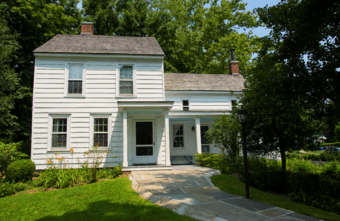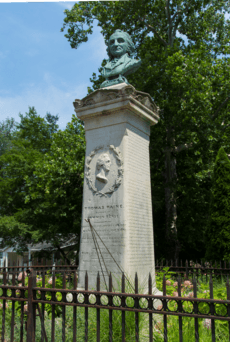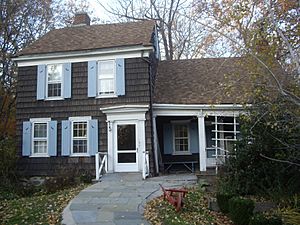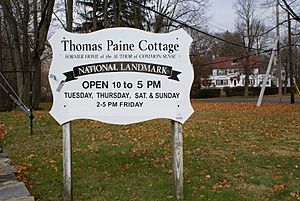Thomas Paine Cottage facts for kids
|
Thomas Paine Cottage
|
|
 |
|
| Location | 20 Sicard Avenue, New Rochelle, New York, USA |
|---|---|
| Area | 2 acres (0.81 ha) |
| Architectural style | Saltbox with Greek Revival elements |
| NRHP reference No. | 72000920 |
Quick facts for kids Significant dates |
|
| Added to NRHP | November 28, 1972 |
| Designated NHL | November 28, 1972 |
The Thomas Paine Cottage is a historic house in New Rochelle, New York. It was the home of Thomas Paine from 1802 to 1806. Paine was a very important person in American history. He wrote a famous pamphlet called Common Sense. He was also one of the Founding Fathers and a hero of the American Revolutionary War.
Paine was buried near the cottage after he died in 1809. His body was later moved in 1819. The cottage was part of a large 300-acre farm. The State of New York gave this farm to Paine in 1784. This was to thank him for his help in America's fight for independence. In August 1805, Paine wrote his last pamphlet here. It was about "Constitutional Reform" for the people of Philadelphia.
The "Huguenot and New Rochelle Historical Association" has owned the cottage since 1910. They run it as a historic house museum. You can visit the cottage most Fridays, Saturdays, and Sundays from 10 a.m. to 5 p.m. Many special events happen there throughout the year. These include a Colonial Fair in spring and a Colonial Tavern night in October. They also host a Toys for Tots drive in December. Many local schools bring students here for field trips.
Contents
Exploring the Cottage's Design
The Thomas Paine Cottage is a two-story house made of wood. It is built in a style called saltbox. It started as a simple building, about 16 feet (4.9 m) wide and 31 feet (9.4 m) deep. In 1804, an extra section was added. This new part was about 18 by 23 feet (5.5 by 7.0 m) and included a porch. Around 1830, a new front door and porch pillars were added. These had a Greek Revival style.
The main part of the house has three rooms in a row. The kitchen is at the front, a common room is in the middle, and a bedroom is at the back. The added section on the right has a parlor. There are four bedrooms upstairs on the second floor. Today, the rooms are decorated to look like they did in the late 1700s and early 1800s. There are also exhibits about the history of New Rochelle. You can learn about the local Siwanoy Native Americans and the Huguenots.
The front door of the cottage opens right into the main room. This room is called the "Huguenot Room." People say the desk in this room belonged to Jacques Flandreau. He was an early Huguenot settler in the town. Above the desk is a steel picture from a famous painting. It shows King Henry IV of France entering Paris in 1594.
The back room on the first floor is known as the "Paine Room." On Christmas Eve in 1805, someone fired a gun into this room. It was an attempt to harm Paine. He wrote about it in a letter:
Whatever the gun was charged with passed through about three or four inches below the window making a hole large enough to (allow) a finger to go through -the muzzle must have been very near as the place is black with powder, and the glass of the window is shattered to pieces.
This room has several interesting items. There are two chairs that Paine used when he stayed at Bayeau's Tavern. This tavern was almost directly across North Avenue. Another special item is a stove in the chimney. Benjamin Franklin gave this stove to Thomas Paine. It is one of the few real Franklin stoves still existing. There is also a warming pan that belonged to Mrs. Sarah Bache. She was Benjamin Franklin's daughter.
Bringing the Cottage Back to Life
In 2009, a big project helped restore the cottage. This made it possible to tell the story of the building more accurately. The people who care for the cottage are part of the Huguenot and New Rochelle Historical Association. They raised money to fix the building, which was over 200 years old. They also wanted to make the building look like it did originally. They used old photos and physical clues to guide them.
They received a $50,000 grant from State Assemblywoman Amy Paulin. Many people also gave donations. The Association hired architect John Woodruff and a restoration company called Salem Preservation, Inc. They worked on the outside of the cottage. The New Rochelle Historical and Landmarks Review Board checked all parts of the project.
The work included removing the old asphalt roof. They replaced it with wood shingles. This also uncovered two original windows on the upper floor. Other major work involved rebuilding a separate roof above the porch. They also replaced the wood shingles on the entire house with Weatherboard. They repaired and replaced gutters and wood trim.
The Cottage's Long History
From Farm to Famous Home
The park where Paine's Cottage stands today is a small part of what was once Thomas Paine's farm. This farm was originally part of a much larger piece of land. Andre Thauvet, an early Huguenot settler of New Rochelle, bought this land in 1690. Thauvet later gave 276 acres to Captain Oliver Besley, another Huguenot. Besley was a Justice of the Peace and a leader of the local militia.
By the time of the American Revolution, the property belonged to Frederick DeVeaux. He was a Loyalist, meaning he supported the British King. DeVeaux actively worked against the American patriots. Because of this, he was found guilty of treason against the State of New York. His property was taken away. DeVeaux left the country and went to Nova Scotia with other Loyalists.
The State of New York gave the farm to Thomas Paine in 1784. This was to honor his "distinguished merit" and "eminent services" during the war. The original stone farmhouse on the Davoue farm burned down in 1793. This happened while Paine was away in France.
The farm was about 277-acre (112 ha) and was first owned by the Loyalist Frederick DeVeaux. It was taken by the state after the war. A total of 320 acres (130 ha) were given to Paine in 1784 by the New York State Legislature for his service to the country.
The Huguenot Association's Role
The Huguenot Association bought the house from Charles See. He wanted to divide the property to build new homes. In 1908, the cottage was moved about 440 yards (400 m) west to its current spot at 20 Sicard Avenue. This is the last remaining part of the original farm that Paine owned.
The current cottage was built in 1793. It was near the Davoue house on the south side of Paine Lane (now Paine Avenue). The house was built in two parts. The western part was built soon after 1793. The eastern part was probably added around 1804. Paine owned the property for 25 years. He seemed to lease it out for much of that time. He wasn't really a farmer. His letters show that writing was his main job. Farming was less important to him. He described the farm in a letter to Thomas Jefferson in 1804:
Saving the Cottage for History
After the Thomas Paine Monument was built in 1839, people tried to save the cottage. They wanted it to be another memorial to Paine. One big effort happened in 1850. Not only was the cottage bought, but also a large part of the original farm. However, this plan was later stopped, and the property was sold.
It wasn't until 1908 that the efforts to save the cottage finally worked. At that time, the house either had to be moved or torn down. The owner, Charles W. Seer, generously gave it to the New Rochelle Huguenot Association. They then bought the park where the cottage now stands. This park was part of the Paine farm. The cottage was moved to its current location. It was repaired and set up as a museum and historical center. It officially opened to the public on July 14, 1910.
Around the Cottage Grounds

Paine's Burial Spot
Paine passed away in Greenwich Village, New York on June 8, 1809. He wanted to be buried in the Quaker cemetery. But because of his writings, they said no. His few remaining friends brought his body back to New Rochelle. They buried him on his farm, as he wished in his will:
I know not if the Society of People called Quakers admit a person to be buried in their burying Ground, who does not belong to their Society, but if they do or will admit me, I would prefer being buried there my father belonged to that profession, and I was partly brought up in it. But if it is not consistent with their rules to do this I desire to be buried on my farm at New Rochelle. The place where I am to be buried to be a square of twelve feet, to be enclosed with Rows of Trees, and a Stone or Post & rail fence, with a headstone with my name and age engraved upon it, Author of 'Common Sense'.
The spot chosen for his grave was in the northwest corner of the field. It was just south of the old Davoue Farm lane, near North Avenue. A marble headstone marked the spot, and a low stone wall surrounded it.
In 1819, an English writer named William Cobbett moved Paine's remains to England. He wanted to build a bigger memorial. But Cobbett died before he could finish, and the remains disappeared. Dr. Moncure D. Conway said he found a piece of Paine's brain around 1905. It was later buried under the monument on October 14, 1905. People are still looking for other parts of Paine's body. In 2001, scientists suggested DNA tests for a piece believed to be his skull.
The Paine Museum
Next to the cottage is a museum built in 1925. It is dedicated to Thomas Paine. The Thomas Paine National Historical Association created it. This group started in 1905. It is not connected to the cottage or the Huguenot and New Rochelle Historical Association. In 2005, the association sold some of its important items. This included a first edition of Common Sense. They did this to pay for repairs to the museum building.
Paine's Monument
The Thomas Paine Monument was created by Gilbert Vale. He was a writer and publisher from New York. John Frazee, a sculptor, made the marble monument. Later, in 1881, a bronze statue of Paine by Wilson McDonald was added. The monument was moved next to the cottage's current location in 1905. The city of New Rochelle now owns it.
Sophia Brewster Schoolhouse
The Sophia Brewster One-Room Schoolhouse was also moved to the property. This was the oldest private school in New Rochelle.





